
The Lockheed Vega is an American six-passenger high-wing monoplane airliner built by the Lockheed Corporation starting in 1927. It became famous for its use by a number of record-breaking pilots who were attracted to the rugged and very long-range design. Amelia Earhart became the first woman to fly solo across the Atlantic Ocean in one, and Wiley Post used his to prove the existence of the jet stream after having flown around the world twice.

The ERCO Ercoupe is an American low-wing monoplane aircraft that was first flown in 1937. It was first manufactured by the Engineering and Research Corporation (ERCO) shortly before World War II; several other manufacturers continued its production after the war. The final model, the Mooney M-10, first flew in 1968 and the last model year was 1970. It was designed to be the safest fixed-wing aircraft that aerospace engineering could provide at the time and the type continues to enjoy a faithful following.

The Taylor Titch is a British fixed-wing homebuilt aircraft, developed in the 1960s by J.F. Taylor. As of 2015, examples are still being built and flown.

The Sikorsky S-39 was an American light amphibious aircraft produced by Sikorsky Aircraft during the early 1930s. The S-39 was a smaller, single-engine version of the S-38.
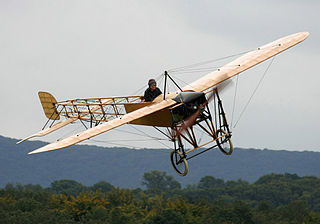
The Blériot XI is a French aircraft of the pioneer era of aviation. The first example was used by Louis Blériot to make the first flight across the English Channel in a heavier-than-air aircraft, on 25 July 1909. This is one of the most famous accomplishments of the pioneer era of aviation, and not only won Blériot a lasting place in history but also assured the future of his aircraft manufacturing business. The event caused a major reappraisal of the importance of aviation; the English newspaper The Daily Express led its story of the flight with the headline "Britain is no longer an Island".

The Luscombe 8 is a series of high-wing, side-by-side-seating monoplanes with conventional landing gear, designed in 1937 and built by Luscombe Aircraft.

The All American 10A Ensign was a two-seat light plane built in the United States shortly after World War II. It was a low-wing, all-metal cantilever monoplane with fixed tricycle undercarriage and which seated its pilot and passenger side by side under an expansive bubble canopy. Due to the glut of military surplus aircraft on the civil market after the war, All American was unable to attract buyers and no production ensued.
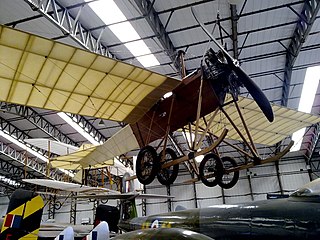
The Blackburn Mercury was an early British aircraft designed as a pilot trainer for the Blackburn Flying School, Filey, in 1911. It was an enlarged, two-seat version of the Second Monoplane that flew earlier that year. It was a mid-wing monoplane of conventional configuration that accommodated pilot and student in tandem, open cockpits. This prototype was displayed at the Olympia Aero Show in March 1911 and led to orders being placed for two racers to participate in the Daily Mail Circuit of Britain race. The first of these crashed on takeoff, and the second was first rebuilt into a two-seat trainer, then into a single-seat trainer known as the Type B. Another six Mercuries were built for various private buyers.
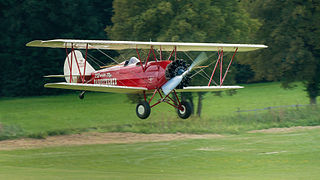
The Travel Air 2000/3000/4000 (originally, the Model A, Model B and Model BH were open-cockpit biplane aircraft produced in the United States in the late 1920s by the Travel Air Manufacturing Company. During the period from 1924–1929, Travel Air produced more aircraft than any other American manufacturer, including over 1,000 biplanes. While an exact number is almost impossible to ascertain due to the number of conversions and rebuilds, some estimates for Travel Air as a whole range from 1,200 to nearly 2,000 aircraft.
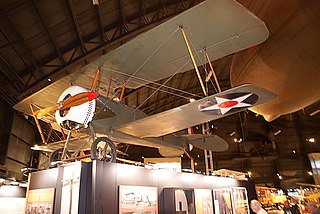
The Thomas-Morse S-4 Scout was an American biplane advanced trainer, operated by the United States Army and the United States Navy. Dubbed the "Tommy" by pilots who flew it, the aircraft became the favorite single-seat training airplane produced in the U.S. during World War I. It had a long and varied career beginning with the S-4B, which first appeared in the summer of 1917.

The Bullet Monoplane or Alexander Eaglerock Bullet was a low wing cabin monoplane that was a departure from traditional biplane aircraft of the era.

The Culver Model V was a two-seat cabin monoplane designed and built by the Culver Aircraft Company.
The Brown Aircraft Co was an American aircraft manufacturer of the 1930s and 1940s.
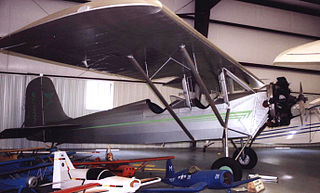
The Timm Collegiate was a series of American-built two-seat light aircraft of the late 1920s.

The Baumann Brigadier was a prototype American light transport aircraft of the late 1940s. It was a twin-engined monoplane, which, unusually, was of pusher configuration. Only two were built, plans for production never coming to fruition.
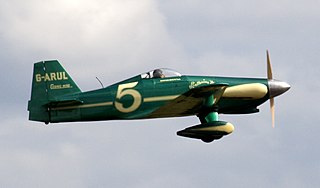
The LeVier Cosmic Wind was a small single engine, single seat racing monoplane designed and built by staff of the Lockheed Corporation in 1947. It did not race successfully in the US but one won the premier cross-country competition in the UK in 1964. It still flies today.

The Brown B-2 Racer was an American-built small monoplane racing aircraft built in 1934.

The Travel Air 5000 was an early high-wing monoplane airliner and racing monoplane designed by Clyde Cessna and is chiefly remembered for being the winner of the disastrous Dole Air Race from California to Hawaii.

The Wedell-Williams Model 22 was a racing aircraft, two examples of which were built in the United States in the early 1930s by the Wedell-Williams Air Service Corporation. It was one of three early projects by aircraft designer Jimmy Wedell to create a racer and was built specifically to compete in the 1930 All-American Flying Derby from Buffalo to Detroit. It was a braced, low-wing monoplane originally powered by an inline Cirrus engine and equipped with fixed landing gear in large spats.
The Emsco B-4 Cirrus was a mid-wing, two-seat trainer built in the US in the late 1920s. Six were built and three variants with more powerful engines flown.


















